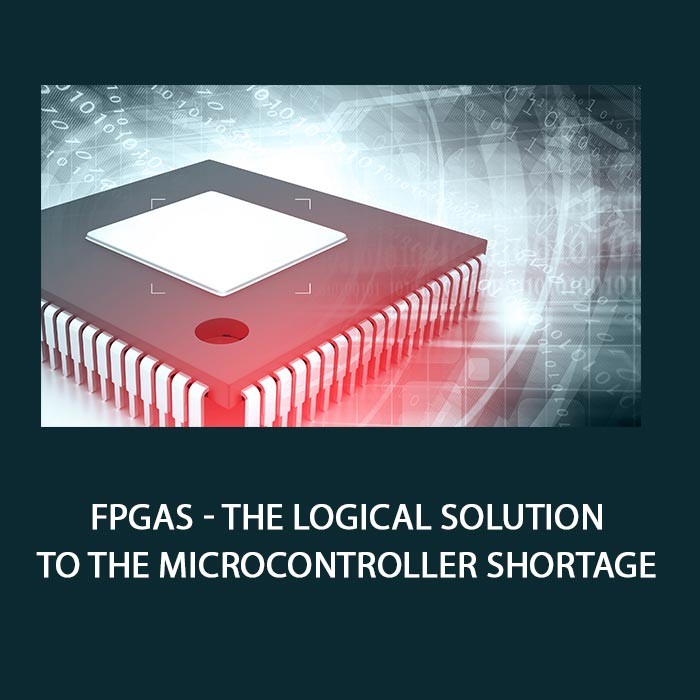
Today’s marketplace is getting heavily disrupted by the current semiconductor chip shortage that has hampered our manufacturing production lines. This is evident by the limited supply of products available.
For example, automobile production has decreased from 2020 to 2021 as well as consumer products like smartphones. New product launches are also delayed as manufacturers figure out new supply chains and vendors to get them over these supply hurdles. The current view is that the semiconductor shortage will extend well into 2022 and maybe even longer.
One of the lack of devices causing major impacts to the supply chain, and thus manufacturing, is the microcontroller. A microcontroller is a compact integrated circuit designed to execute operations, similar to a microprocessor, and typically found in embedded systems. You can imagine these devices are sprinkled all over your automobile, from the power engine to the infotainment (radio) controls, aiding in the safety, control, and entertainment portions of the automobile. Without these microcontrollers, automobile production and supply diminish. Therefore, what alternatives do engineers and supply chain managers have?
Since microcontrollers are essentially executing logic commands to perform an operation, an alternative to microcontrollers is the Field Programmable Gate Array (FPGA). An FPGA is an integrated circuit made up of a matrix of configurable logic blocks. Therefore, by configuring the FPGA, you can essentially perform the same operations as a microcontroller. There are three techniques to look at when considering FPGAs to replace a microcontroller:
- An FPGA can replace a microcontroller’s simple operation by programming combinatorial logic or a state machine in the configurable logic blocks.
- An FPGA can be programmed with a “softcore” microcontroller in the configurable logic blocks to run the same software that is being run on the current microcontrollers. In otherwords, no change to the software is necessary.
- An FPGA can be purchased with a “hardcore” microcontroller that is permanently fixed in the device silicon. This can run the same software that is being run on the current microcontroller, only faster than a softcore solution.
There are inherent advantages to using an FPGA over a microcontroller. For an embedded design engineer, these advantages can help achieve cost and performance targets. The first is the flexibility of programmable IO that an FPGA can offer.
While a microcontroller has fixed and limited IO, an FPGA can be programmed for various IO interface standards (I2C, I2S, RGB, MIPI, etc) thereby acting as a bridge, an IO expander, or a signal aggregator. Next, a microcontroller executes its operations by software in a serial function. The speed of the operation is controlled by the length of the code and system clock. On the other hand, operations in an FPGA are in the silicon configurable logic blocks which are faster to execute than lines of codes. And you can also create separate circuits in the configurable logic blocks to run operations in parallel. A microcontroller can’t do this parallelism. Lastly, a microcontroller burns active power in its wait states; it always needs to run code while waiting for an interrupt. An FPGA, on the other hand, burns only leakage power in its always-on wait state which makes it a much better solution for low power applications than a microcontroller.
GOWIN Semiconductor offers solutions to address the three microcontroller replacement techniques listed above. GOWIN’s FPGAs come in a variety of configurable logic block sizes and flexible input/output configurations. GOWIN offers many microcontroller softcores including the Cortex M series and RISC-V. Lastly, GOWIN offers FPGAs with hardcore microcontrollers in silicon to achieve the best performance value possible.
Understanding that there are alternatives to overcome the microcontroller shortages can be beneficial to manufacturing, supply chain managers, and to the marketplace as a whole. And design engineers will recognize that:
- Flexible interfaces, bridging, io expanision, and signal aggregation
- • Acceleration/Parallel processing
- • Always-on low power operations
can be an advantage to any embedded system looking to achieve performance and cost targets. GOWIN Semiconductor is here to help those in need of moving their manufacturing and product launches forward with FPGA products less than $1. Please visit us at www.gowinsemi.com for more information about our small size, low power, and low cost products and solutions.
By Scott Casper, GOWIN Semiconductor Corporation